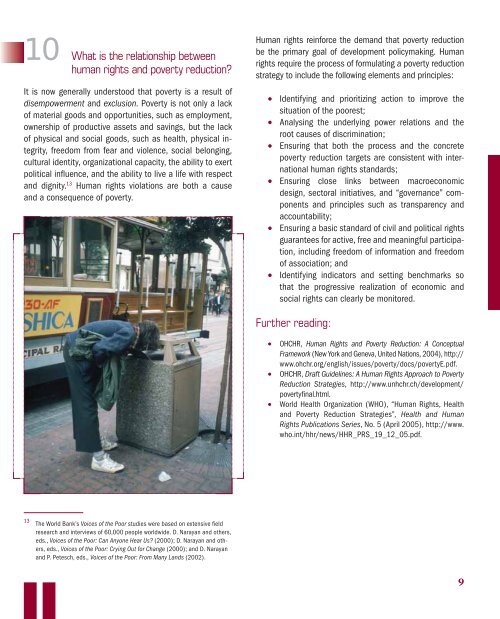10 What is the relati<strong>on</strong>ship betweenhuman rights and poverty reducti<strong>on</strong>?It is now generally understood that poverty is a result ofdisempowerment and exclusi<strong>on</strong>. Poverty is not <strong>on</strong>ly a lackof material goods and opportunities, such as employment,ownership of productive assets and savings, but the lackof physical and social goods, such as health, physical integrity,freedom from fear and violence, social bel<strong>on</strong>ging,cultural identity, organizati<strong>on</strong>al capacity, the ability to exertpolitical influence, and the ability to live a life with respectand dignity. 13 <strong>Human</strong> rights violati<strong>on</strong>s are both a causeand a c<strong>on</strong>sequence of poverty.<strong>Human</strong> rights reinforce the demand that poverty reducti<strong>on</strong>be the primary goal of development policymaking. <strong>Human</strong>rights require the process of formulating a poverty reducti<strong>on</strong>strategy to include the following elements and principles:Identifying and prioritizing acti<strong>on</strong> to improve thesituati<strong>on</strong> of the poorest;Analysing the underlying power relati<strong>on</strong>s and theroot causes of discriminati<strong>on</strong>;Ensuring that both the process and the c<strong>on</strong>cretepoverty reducti<strong>on</strong> targets are c<strong>on</strong>sistent with internati<strong>on</strong>alhuman rights standards;Ensuring close links between macroec<strong>on</strong>omicdesign, sectoral initiatives, and “governance” comp<strong>on</strong>entsand principles such as transparency andaccountability;Ensuring a basic standard of civil and political rightsguarantees for active, free and meaningful participati<strong>on</strong>,including freedom of informati<strong>on</strong> and freedomof associati<strong>on</strong>; andIdentifying indicators and setting benchmarks sothat the progressive realizati<strong>on</strong> of ec<strong>on</strong>omic andsocial rights can clearly be m<strong>on</strong>itored.Further reading:OHCHR, <strong>Human</strong> <strong>Rights</strong> and Poverty Reducti<strong>on</strong>: A C<strong>on</strong>ceptualFramework (New York and Geneva, United Nati<strong>on</strong>s, 2004), http://www.ohchr.org/english/issues/poverty/docs/povertyE.pdf.OHCHR, Draft Guidelines: A <strong>Human</strong> <strong>Rights</strong> <strong>Approach</strong> to PovertyReducti<strong>on</strong> Strategies, http://www.unhchr.ch/development/povertyfinal.html.World Health Organizati<strong>on</strong> (WHO), “<strong>Human</strong> <strong>Rights</strong>, Healthand Poverty Reducti<strong>on</strong> Strategies”, Health and <strong>Human</strong><strong>Rights</strong> Publicati<strong>on</strong>s Series, No. 5 (April 2005), http://www.who.int/hhr/news/HHR_PRS_19_12_05.pdf.13The World Bank’s Voices of the Poor studies were based <strong>on</strong> extensive fieldresearch and interviews of 60,000 people worldwide. D. Narayan and others,eds., VoicesofthePoor:CanAny<strong>on</strong>eHearUs? (2000); D. Narayan and others,eds., Voices of the Poor: Crying Out for Change (2000); and D. Narayanand P. Petesch, eds., Voices of the Poor: From Many Lands (2002).9
11 What is the relati<strong>on</strong>shipbetween human rights and goodgovernance?Governance refers to mechanisms, instituti<strong>on</strong>s and processesthrough which authority is exercised in the c<strong>on</strong>ductof public affairs. The c<strong>on</strong>cept of good governance emergedin the late 1980s to address failures in development policiesdue to governance c<strong>on</strong>cerns, including failure to respecthuman rights. The c<strong>on</strong>cepts of good governance andhuman rights are mutually reinforcing, both being based<strong>on</strong> core principles of participati<strong>on</strong>, accountability, transparencyand State resp<strong>on</strong>sibility.<strong>Human</strong> rights require a c<strong>on</strong>ducive and enabling envir<strong>on</strong>ment,in particular appropriate regulati<strong>on</strong>s, instituti<strong>on</strong>s andprocedures framing the acti<strong>on</strong>s of the State. <strong>Human</strong> rightsprovide a set of performance standards against whichGovernments and other actors can be held accountable. Atthe same time, good governance policies should empowerindividuals to live with dignity and freedom. Although humanrights empower people, they cannot be respected andprotected in a sustainable manner without good governance.In additi<strong>on</strong> to relevant laws, political, managerialand administrative processes and instituti<strong>on</strong>s are neededto resp<strong>on</strong>d to the rights and needs of populati<strong>on</strong>s. Thereis no single model for good governance. Instituti<strong>on</strong>s andprocesses evolve over time.<strong>Human</strong> rights strengthen good governance frameworks.They require: going bey<strong>on</strong>d the ratificati<strong>on</strong> of human rightstreaties, integrating human rights effectively in legislati<strong>on</strong>and State policy and practice; establishing the promoti<strong>on</strong>of justice as the aim of the rule of law; understanding thatthe credibility of democracy depends <strong>on</strong> the effectivenessof its resp<strong>on</strong>se to people’s political, social and ec<strong>on</strong>omicdemands; promoting checks and balances between formaland informal instituti<strong>on</strong>s of governance; effecting necessarysocial changes, particularly regarding gender equalityand cultural diversity; generating political will and publicparticipati<strong>on</strong> and awareness; and resp<strong>on</strong>ding to key challengesfor human rights and good governance, such ascorrupti<strong>on</strong> and violent c<strong>on</strong>flict.12 What is the relati<strong>on</strong>ship betweenhuman rights and ec<strong>on</strong>omic growth?Ec<strong>on</strong>omic growth is a means, not the goal, of development.It can also be instrumental for the realizati<strong>on</strong> of humanrights. However, ec<strong>on</strong>omic growth must be achieved in amanner c<strong>on</strong>sistent with human rights principles.Certain ec<strong>on</strong>omic, social and cultural rights may be realized<strong>on</strong>ly progressively, over time, due to legitimate resourcec<strong>on</strong>straints (see questi<strong>on</strong> 3). States are under an obligati<strong>on</strong>to take measures to realize these rights as expeditiously aspossible. Since resources are needed to realize these particularrights, their speedy realizati<strong>on</strong> depends <strong>on</strong> softening theresource c<strong>on</strong>straint, which in turn requires ec<strong>on</strong>omic growth.A faster rate of growth can also help ease the pain of makingunavoidable trade-offs, by increasing available resources.It must be understood, however, that ensuring faster growth is<strong>on</strong>e thing and harnessing its potential for the cause of humanrights is another. For ec<strong>on</strong>omic growth to lead to the realizati<strong>on</strong>of human rights, any growth strategy must be part of a comprehensiveset of policies and instituti<strong>on</strong>s c<strong>on</strong>sciously designed toc<strong>on</strong>vert resources into rights. This comprehensive frameworkhas both internati<strong>on</strong>al and nati<strong>on</strong>al dimensi<strong>on</strong>s, the particularsof which vary from case to case, a process guided by thec<strong>on</strong>diti<strong>on</strong>s outlined in questi<strong>on</strong> 14 below. A key role of UnitedNati<strong>on</strong>s agencies is to help ensure that ec<strong>on</strong>omic growth istranslated into the wider enjoyment of human rights for all. 1414Ec<strong>on</strong>omic growth al<strong>on</strong>e is not enoughGrowth al<strong>on</strong>e is not enough. Growth without equity, without socialinclusi<strong>on</strong>, will not reduce poverty. “Equity has an instrumentallogic (redistributi<strong>on</strong> can make growth easier and poverty reducti<strong>on</strong>faster) but also has intrinsic value in a fair global society.”Source: Sim<strong>on</strong> Maxwell, “The Washingt<strong>on</strong> C<strong>on</strong>sensus is dead! L<strong>on</strong>g live themeta-narrative!”, ODI working paper 243 (L<strong>on</strong>d<strong>on</strong>, Overseas DevelopmentInstitute, January 2005), p. 6, http://www.odi.org.uk/publicati<strong>on</strong>s/working_papers/wp243.pdf.“Study <strong>on</strong> policies for development in a globalizing world: What can thehuman rights approach c<strong>on</strong>tribute?” by Professor S. R. Osmani (E/CN.4/Sub.2/2004/18), paras. 21-28.10
















